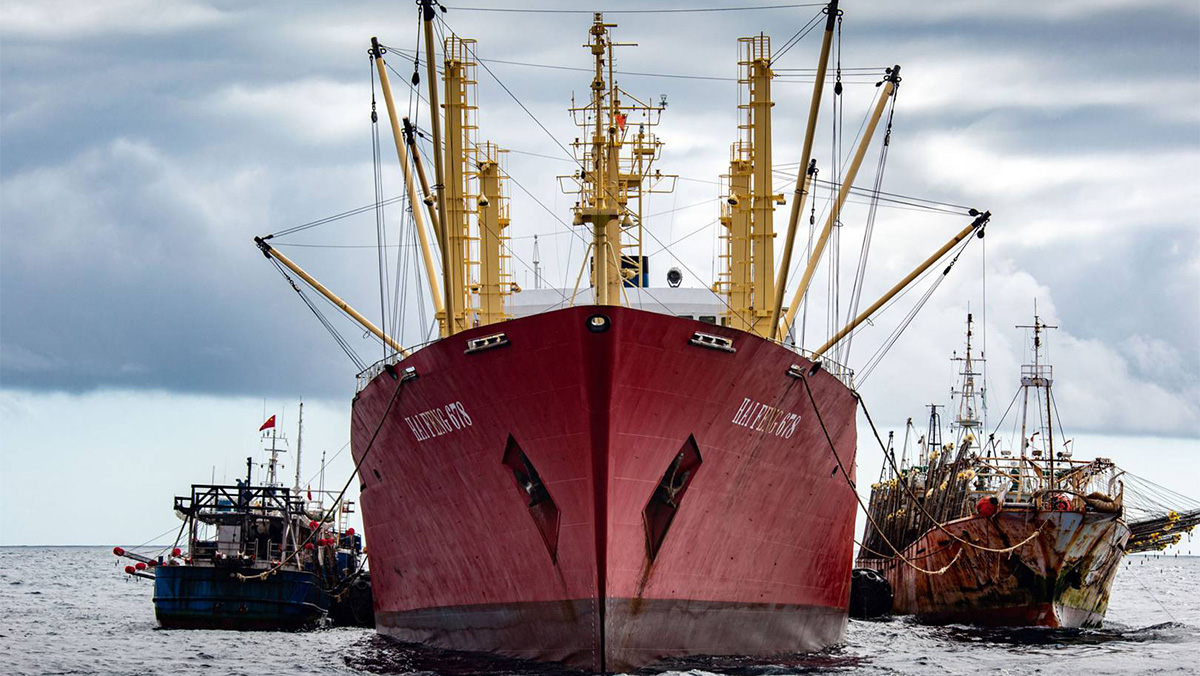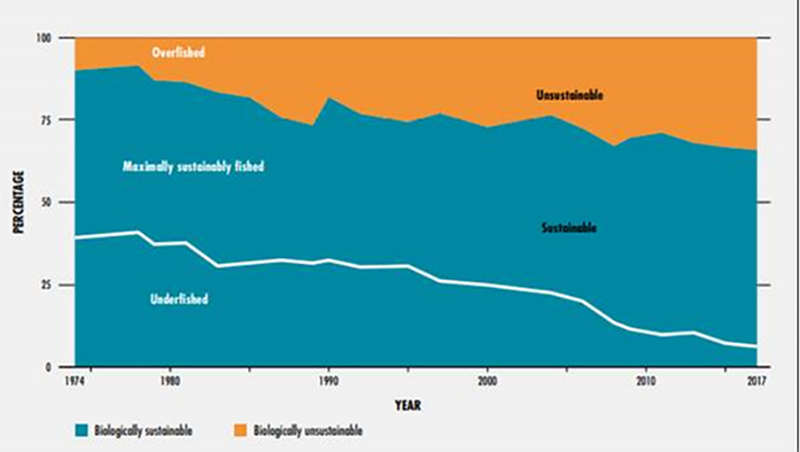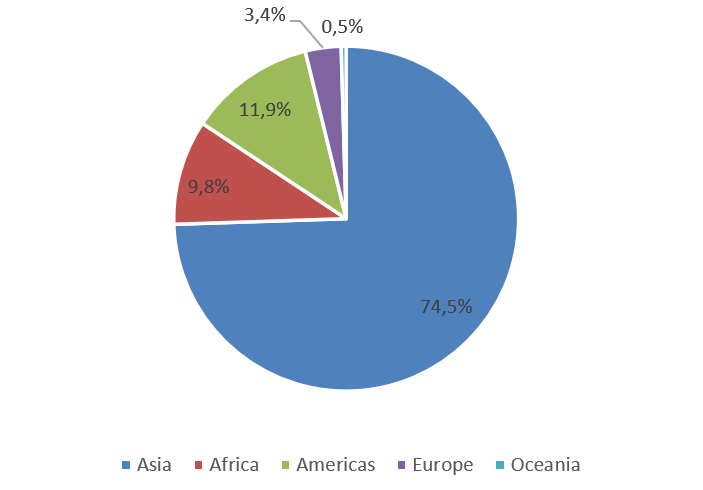Written by David Vivas-Eugui and Claudia Contreras, Article No. 68 [UNCTAD Transport and Trade Facilitation Newsletter N°88 - Fourth Quarter 2020]

A significant share of global fish stocks and related marine ecosystems are at risk. The percentage of stocks fished at biologically unsustainable levels increased from 10 percent in 1974 to 34.2 percent in 2017 (FAO, 2020). In addition, the maximally sustainably fished stocks have increased to 59.6 per cent in 2017, partly reflecting improved implementation of management measures. This indicates that both sustainable and unsustainable fishing activities are increasing at the expense of underfished stocks (mainly non-commercial species), which has shown a decreasing trend since the late 1970’s (Figure 1). This means that we have reached the limit of what can be harvested from the ocean and such harvest can modestly grow again if sustainability is fully mainstreamed into global fisheries.
Figure 1: Global trends in the state of the world’s marine fish stocks, 1974–2017

Source: FAO (2020). The State of World Fisheries and Aquaculture (SOFIA) 2020
The high seas are open to all and fishing is listed among the freedoms of the seas under the UN Convention on the Law of the Sea. In order to conserve and sustainably use and manage straddling highly migratory fish stocks such as tuna, Parties to the UN Fish Stock Agreement are required to join and cooperate with the Regional Fish Management Organisations (RFMOs) made up of nations surrounding a high seas area and in conservation and management. Several FAO Agreements, codes of conduct and soft law complement and deepen these treaties. Implementation and compliance are left to Members of the RFMOs, Coastal, Flag and Port States with still significant differences on how this is done in practice.
What is wrong?
Concerns include that regulations and compliance systems, especially by some States with large distant water fleets, seem insufficient, too lax and ineffective in many cases. Others argue that there is a senseless race to bottom by over-sized fleets seeking to increase or sustain capacity without a clear economic rationale. There are also concerns regarding the impact that some fishing methods can produce on the marine ecosystem, potentially affecting the sustainability of other marine species and the livelihoods of local fishermen. These concerns relate to certain regulatory gaps under the Law of the Sea, multilateral fisheries treaties and regional management regimes within the global trade system and to low levels of cooperation in transparency, surveillance, monitoring and enforcement. Additionally, certain harmful subsidies that contribute to overcapacity and overfishing, and to illegal, unreported and unregulated (IUU) fishing remain undisciplined at the global level and subject to negotiations under relevant WTO Ministerial Decisions and target 6 of SDG 14.
Efforts for conservation and management measures have improved but efforts to tackle unsustainable fishing do not seems to be sufficiently effective so far. The current size of global fishing fleets is not commensurate with available stocks. The effective Capture per Unit of Effort (CPUE) of most countries in 2015 was a fifth of its 1950s value (meaning fleets must undertake five times more fishing effort in terms of resources and time for the same amount of catch) (Rosseau et al, 2018). In 2018, the global total of fishing vessels was estimated to be 4.56 million, from 1.7 million in 1950 with motorised vessels representing 63 per cent of the total. Asian countries represent 74.5 per cent of the motorised vessels fleet globally, followed by the Americas, Africa and Europe with 11.9 per cent, 9.8 percent and 3.4 respectively[i] (figure 1). Efforts have been deployed by China to reduce its fleet and by the European Union not to increase its size. However, these efforts may be partly offset by investment in overcapacity. Under the current situation Asian countries and other regions with large fishing fleets, have a significant responsibility in curbing global stock depletion, in deterring and phasing out IUU fishing and in enhancing flag State controls as well as cooperation with RFMOs.
Figure 2: Distribution of motorised fishing vessels by region (flag), 2018

According to recent academic estimates[i], subsidies to the fishing industry amounted to around $35.2 billion per year, of which around $22.2 billion were given to activities that enhance capacity (Sumaila et al., 2019). Public support by the OECD Members (OECD 33) and other analysed States to the fisheries sector has reached an average of about $9.2 billion during the period 2010-2015[ii]. In 2016, public support estimates for OECD Members were about $4 billion annually. If China is added, an additional $4 billion will have to be added to this amount for the same year. According the same source, subsidies from OECD countries and from China have decreased since 2014 by about a $1 billion. Such a reduction seems to be the consequence of internal policy reform in the fisheries sector, increased international public oversight and civil society campaigns, set under the context of SDG 14.6 as well as advances in towards a comprehensive WTO agreement on fish subsidies.
Depending on how subsidies are allocated, there could be a direct correlation between public support, fleets size and overcapacity. Public resources allocated to acquire new vessels, modernise vessels and cover fishing operational costs (such as fuel, ice and bait) generate incentives to fish more and for longer without a clear relation with actual cost or catch, particularly by nations that already have huge fleets. Most fish subsidies support high seas operations that would not be profitable otherwise. While potentially undervalued, high seas profits have been estimated to range from $0.3 to 1.4 billion (Sale et all, 2018). Such estimates indicate that about $4.2 billion may end subsidising high seas fishing showing that profitability of high seas fishing would not be even close to current levels without undue public support.
The impacts of COVID-19 on the fisheries sector could be significant. Exports by most countries may decline between 15 to 60 percent in 2020, with potentially lower declines in 2021, depending on governmental emergency and sanitary measures implemented by importing and exporting countries. The pandemic has created the need for additional sanitary and security measures to protect crews and processing facilities to ensure the virus and any other pathogens do not make it into the final product, and to sustain income of unemployed or non-active fishermen. There could be an increase or redirection of existing public support to the fisheries sector in 2020 and 2021, which may go to mitigation of social and sanitary impacts and keep the sector afloat. For example, France may provide support for €650 million for the maritime sector, including in fisheries and aquaculture, to address the current sanitary and economic crises. The United States Secretary of Commerce announced the allocation of $300 million in fisheries assistance funding because of the pandemic. In certain developing countries, direct income support for unemployment and lack of economic has been given to local and coastal population (UNCTAD, 2020).
What can be done?
The complexity of the problem at hand does not provide for easy answers. To advance towards achieving SDG 14 countries need to increase efforts towards:
- Enhancing international cooperation: There is no substitute for enhanced international cooperation if there is an interest in reducing fishing fleets sizes, overcapacity and to phase out harmful subsidies. Increased emphasis on transparency, regional management and joint control, monitoring surveillance is fundamental, especially by non-Members of multiple RFMOs. Coastal, Flag and Port State regulatory and compliance efforts need to be notified and compiled in a comparable way and be subject to peer review by other States under existing RFMOs and United Nations multilateral settings (e.g. Model MoUs to improve the coordination and efficiency of the implementation of port State measures by national agencies under Indian Ocean Tuna Commission).
- Strengthening measures to fight IUU fishing. It is time for the creation of an intergovernmental e-platform for IUU vessel listing, notification and logging of denunciations and evidence by coastal, flag and port states. The FAO Global Record of fishing vessels and refrigerated transport and supply vessels is an essential tool enabling vessel transparency and the fight against IUU fishing. To date, 11,162 vessels have been added to this global record, some of them of large tonnage. The number of large motorised fishing vessels with more than 24 meters long can be estimated at 143,000 vessels[ii]. The Global Record platform allows identifying vessels by Unique Vessels Identifiers, using the IMO ship identification number scheme, and introducing data on authorisations, inspections, port measures and IUU vessel listing. However, the reporting of the latter is relatively low or inexistent for most large-size vessels. Additional incentives to filling data may be needed. Furthermore, information on vessel supplies, especially fuel, is also urgently needed to link it with discussions on fuel subsidies. Tools and political will are essential to increase notifications and data sharing. Several civil society organisations have been compiling IUU vessels lists, mainly from RFMOs sources, but it is not enough and more needs to be done at the national level. In addition, methods need to be explored to better measure fishing efforts by major fleets and potentially link these to numeric caps and reduction schemes that are proportional to a sustainable use of stocks in the high seas.
- Increasing the ratifications to the FAO Port State Measures Agreement (PSMA) and the IMO Cape Town Agreement. The PSMA is a binding international agreement whose objective is to prevent, deter and eliminate IUU fishing by preventing vessels engaged in such activities from using ports and landing their catches. The PSMA is in force since 2016. The Cape Town Agreement (2012) outlines fishing vessel standards and includes other regulations designed to protect the safety of crews and observers. The treaty will enter into force 12 months after at least 22 States, with an aggregate 3,600 fishing vessels of 24 m and over in length, operating on the high seas have expressed their consent to be bound by it. A wider ratification-base for these two instruments will allow stricter control on fishing vessels’ activities at the port and on the design and construction of vessels and will assist in curbing IUU fishing globally. Complementary and more flexible measures to the Cape Town Agreement will also be needed for vessels that are smaller than 24 meters to ensure international control of a large share of the global fishing fleets.
- Shifting efforts from subsidies that hinder sustainable fishing to public support for a blue recovery. There is no better time to introduce subsidies reform than during the COVID-19 pandemic and post-pandemic period. It is crucial to completely shift from harmful subsidies to public support that enable sustainable management and use of stocks (more selective fishing), shift of economic activities by affected populations (e.g. toward sustainable aquaculture and port logistics), and improve sanitary and human rights and labour performance at the high seas. This can be done by States within their jurisdiction and as a complement to a future WTO outcome on fish subsidies. The UNCTAD-FAO-UNEP Inter Agency Plan of Action on SDG 14 could be a vehicle for enabling such reform. Any WTO outcome on fish subsidies must be as comprehensive and effective as possible and address subsidies that contribute to IUU fishing, to fishing overfished stocks and to overcapacity. Disciplines for overcapacity should be maintained and enhanced in current negotiations, whether linked or delinked to overfishing, as vessel operations with no enforceable and effective control by government authorities can lead to the continuation of overexploitation.
[i] FAO data (2019), Distribution of motorized fishing vessels by region, 2018
[ii] U. Rashid Sumaila, Naazia Ebrahim, Anna Schuhbauer, Daniel Skerritt, Yang Li, Hong Sik Kim, Tabitha Grace Mallory, Vicky W.L. Lam, Daniel Pauly. Updated estimates and analysis of global fisheries subsidies, Marine Policy,
Volume 109, 2019.
[iii] United Nations (2019). Advancing Sustainable Development Goal 14. Estimates based on OECD Fisheries Support Estimates database, 2019.
[iv] UNCTAD estimates based on FAO data (2018).
David Vivas-Eugui | Legal Officer | UNCTAD Trade, Environment, Climate Change and Sustainable Development Branch | david.vivaseugui@unctad.org
Claudia Contreras | Economic Affairs Officer | UNCTAD Trade, Environment, Climate Change and Sustainable Development Branch | claudia.contreras@unctad.org



